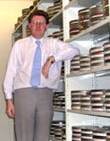|
|
This topic comprises 3 pages: 1 2 3
|
|
Author
|
Topic: DCPs with 1.33 or 1.37
|
|
|
|
|
|
|
|
|
Leo Enticknap
Film God

Posts: 7474
From: Loma Linda, CA
Registered: Jul 2000
|
 posted 09-09-2013 06:31 PM
posted 09-09-2013 06:31 PM





quote: Manny Knowles
Note - on some of the 1.33/1.37 titles, I recommend moving past the credits because those are sometimes "window boxed" with black borders all the way around. I suspect these DCP's share a common source with the bluray. Trusting the credits such a show would result in severe over-cropping. IIRC, "Treasure of the Sierra Madre" is an example of this.
That seems to be a Warner Bros thing. I've got Warner DVDs going back to the early 2000s with windowboxed opening credits (e.g. Dark Passage and Mildred Pierce). I'm guessing that the reason they did this is because DVDs could potentially be viewed either on a standard definition consumer TV set connected to the player with an analog lead, which overscans the signal significantly (i.e. the credits would be cropped if there wasn't a border around the edge of the frame), and on PC monitors and HDMI player-to-TV connections, for which there isn't any overscanning. So if on the original film, the credit text goes near the edges of the frame, the windowboxing is needed to ensure that everyone gets to see the credits without any cropping.
However, they seemed to have continued this habit once BDs came along, as well. Sierra Madre was the first Warners 1.37/4:3 BD I bought, and yup, it's got the credit windowboxing, too. Given that unless you're connecting your BD player to a CRT TV via a composite lead (and if you are, you're not likely to care about the picture quality!), there is no way to play a BD with an overscanned picture on consumer hardware, and so I can't understand why they do this. My only guess is the same as yours: that they're using a single digital master from which they then transcode to everything from the DCP to the Netflix stream.
I've never noticed the credit windowboxing trick done by any other DVD or BD label. I'm guessing that the publishers which cater to an educated audience of movie buffs (e.g. Criterion and Kino) assume that their customers will have the technology to view without any risk of overscanning, will not feel the need to legacy-equipment-proof their releases and prepare their masters accordingly.
| IP: Logged
|
|
|
|
Manny Knowles
"What are these things and WHY are they BLUE???"

Posts: 4247
From: Bloomington, IN, USA
Registered: Feb 2002
|
 posted 09-09-2013 09:05 PM
posted 09-09-2013 09:05 PM




Steve, I'll look through my records and see what I find regarding the frequency of 1.33 vs 1.37.
If your Dolby processors are seeing more than 14 projector presets, then I might finally upgrade my software.
Presently, I use 9 full presets for DCP presentations. Preset #10 is variable - I simply re-associate the lens, screen, and LSC files as needed when I encounter odd formats. The name of that preset is actually "DCP-Variable" so that I don't have to reboot the DSS200 in order for it to see/take a name change.
Presets 11 through 13 aren't really presets, they're just screen files, used during shorts programs, where I want to quickly "square up" vertical edges without the screen going black for an inordinately long time between shorts. Preset #14 is reserved for a variable screen file.
Presets greater than #14 are used for non-DCP applications.
| IP: Logged
|
|
|
|
|
|
|
|
|
|
|
|
|
|
|
|
|
|
|
|
All times are Central (GMT -6:00)
|
This topic comprises 3 pages: 1 2 3
|
Powered by Infopop Corporation
UBB.classicTM
6.3.1.2
The Film-Tech Forums are designed for various members related to the cinema industry to express their opinions, viewpoints and testimonials on various products, services and events based upon speculation, personal knowledge and factual information through use, therefore all views represented here allow no liability upon the publishers of this web site and the owners of said views assume no liability for any ill will resulting from these postings. The posts made here are for educational as well as entertainment purposes and as such anyone viewing this portion of the website must accept these views as statements of the author of that opinion
and agrees to release the authors from any and all liability.
|

 Home
Home
 Products
Products
 Store
Store
 Forum
Forum
 Warehouse
Warehouse
 Contact Us
Contact Us




 Printer-friendly view of this topic
Printer-friendly view of this topic















